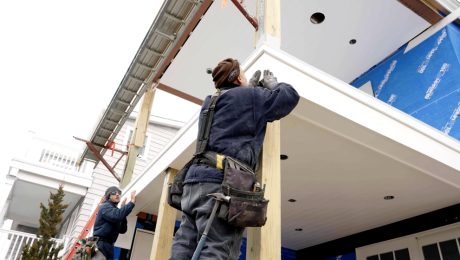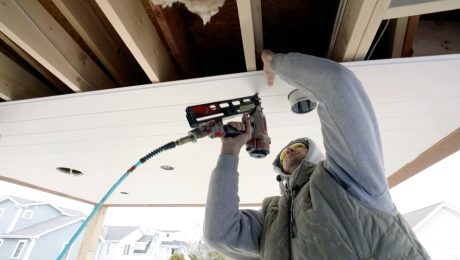What You Need to Know About Installing Steel Siding
In this video, Rob and Brian demonstrate how to cut and install steel siding, as well as what differentiates it from vinyl.
We just finished installing siding on this house, and we used a unique product—steel siding from Vicwest. If you’re familiar with vinyl siding, you’d likely be able to install this product pretty well, although there are some differences. Aesthetically, instead of mimicking lap siding, this product horizontally mimics nickel-gap siding, and the same material can be installed vertically to look like a board siding. There are also differences when it comes to working with the actual material.
Lock edges and cutting
This steel siding has the same kind of lock edge on the bottom and nailing strip on the top. As with vinyl, you start with a starter strip at the bottom of the wall and hook the first piece onto that, working your way up and leaving the screws a little bit loose just like you would with vinyl. But what makes this process really different from installing vinyl is that you are working with a different material that takes different tools to cut. The installation instructions recommend using a chop saw with a metal blade, a circular saw, a jigsaw, and nippers when you’re getting into a steeper angle. We originally started with a jigsaw and the nibblers, both of which were a little bit too rough. Eventually, we ended up switching to the circular saw, using both that and the chop saw for most of our cutting.
J-channel
We figured out a way to locate the vertical pieces in the J-channel as we went without having them drop to the bottom of the channel and without it being open at the top. When running a horizontal piece, you just need to space it evenly between whatever is on both sides, whether that’s a J-channel or a corner trim, and then you set a screw and it just hangs there. But when running a vertical piece, you’re always going to be running it into a J-channel on the bottom, and you want to leave a gap for expansion. To accomplish this, we ripped a little shim out of wood and slid it in at the bottom. Each time we placed a new piece into the J-channel, we rested the board on top of that shim, put in the first screw at a point that would hold the piece up, and then slid the shim out in order to use it for the next course.
Working with steel
Steel scratches easily, so we needed to be extra careful when installing the board. Fortunately, Vicwest provides a touch-up pen for those times when the steel does get scratched. Installing steel siding takes a bit more time than installing other types of siding materials because you need to be more precise with the cuts. But this makes the end result look really nice, with tight and sharp details.
RELATED STORIES


























View Comments
Installing steel siding offers numerous benefits for both residential and commercial properties. Steel siding is known for its durability, low maintenance requirements, and aesthetic appeal. Here are a few thoughts on the matter:
"Choosing steel siding for my home was one of the best decisions I made. Not only does it provide a sleek and modern look, but its durability is impressive. With steel siding, I no longer have to worry about frequent repairs or the effects of weather elements like rain, snow, or even strong winds. It offers excellent protection against moisture, pests, and rot, ensuring the longevity of my home's exterior.
Maintenance is a breeze with steel siding. Unlike other materials, it doesn't require regular painting, staining, or sealing. A simple wash with water and mild detergent is sufficient to keep it looking fresh and vibrant. This low-maintenance aspect has saved me time and money in the long run, allowing me to focus on other aspects of home upkeep.
For More Information
Sidewalk Repair